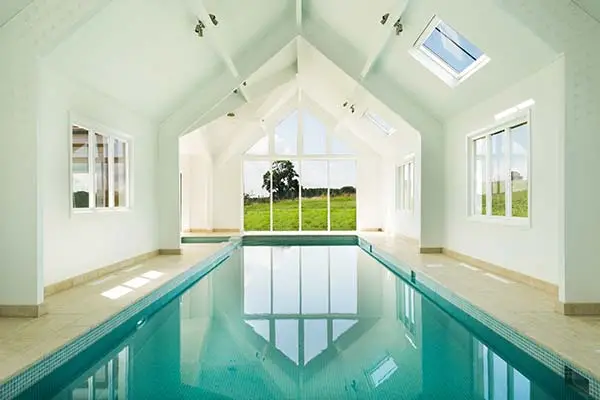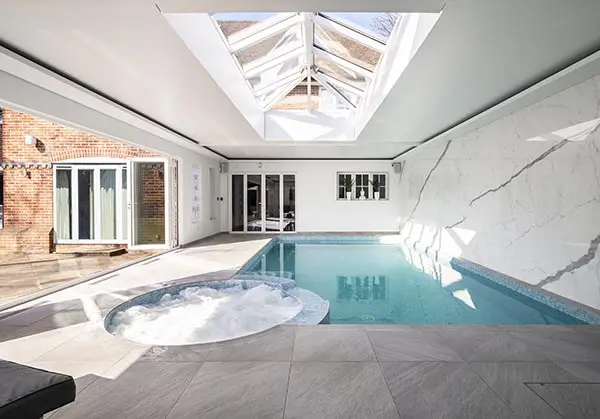Indoor pool running costs will vary greatly depending on the style of swimming pool, its location, the type and grade of enclosure structure, dehumidification, circulation and chemical control.
The water temperature and air temperatures and their heat source along with seasonal influences. Design and construction are critical to achieving cost effective operations through knowledge.
While at the start there are decisions to be made on how your swimming pool is heated and whether you want to consider green alternatives to gas and electricity, there are also quick and easy things you can do once you have your dream pool.
These five top tips are quick fixes for keeping down your swimming pool costs, so you can concentrate on enjoying your new swimming pool.
- Insulate with Swimming Pool Covers
Over 70% of heat is lost through surface water evaporation, so the best quality swimming pool cover is a sound investment. Their function is both heat and vapour retention, lost heat requires replacement and vapour escaping into the pool room environment will require additional dehumidification to protect the building. There are many types to choose from both manual and automatic from solar covers to insulated foam heat retention to rigid PVC slatted to fabric safety covers, a range to suit every application and budget. - Time Your Pumps
Again, design, maintenance and awareness are all factors to efficiency. With some systems, 24 hour plant operation is required, but with others it may be possible to run the circulation pump and filtration for a reduced number of hours per day. For pools where the use range is extreme from little to constant use, we have the option of a variable speed pump to efficiently meet both demands, a 50% reduction in pump speed equals a 50% saving of energy. Most energy providers will offer a range of packages, including reduced rate overnight electricity. Again, the suitability of these arrangements will very much depend on design and how you wish to use your pool. - Take Care Of Your Pool
Maintaining every aspect of your pool’s plant equipment, water balance condition and pool room environmental conditions are prerequisite to achieving the correct running cost for your application. Much of our nation, and indeed the world, has seen how things can go very wrong and very quickly as demonstrated at the recent Rio Olympic Games, where the volume of chemicals, water replacement, reheating and labour hours must have been eye watering! Understanding and knowledge are the keys to the comfortable and efficient operation of your pool. - Review Your Heat Settings
How you wish to use your pool will make a significant difference to the water temperature you choose to maintain. If your pool is for vigorous exercise the water may be cooler than if you are relaxing and less active. So the heating of you indoor pool starts with you and the temperature that you wish to swim at. Once this is established the air temperature can be considered. Too hot is wasteful, too cold will encourage greater humidity and condensation, increasing the work required by your dehumidification equipment to protect the building. This is often misunderstood, resulting in increased overall running cost having set the air too low. Set back devices fitted on some dehumidifiers allow for a reduced air temperature when the pool cover is closed via either a duel setting time clock or by an electronic link to the pool cover. So again we are back to design, knowledge and correct operation. - Pick Energy Efficient Lighting
While it may seem like a small consideration, choosing the most energy efficient lighting for your pool will reduce running costs, especially during the darker winter months. Consider LED long life lighting as, while these will be slightly more expensive, they use up to 75% less energy, last longer and will save having to regularly replace lamps in hard to reach areas, such as over the swimming pool
For those who haven’t yet started the build process, there is plenty of choice when it comes to in-built energy solutions. Here’s a snapshot of the top 5 energy decisions that you should be making before the project begins.
- Consider A Heat Pump
Heating your pool will be one of the most significant running costs to be considered, more commonly green options are being considered as either a total system or a partial back up to the current conventional systems. Heat pumps are an increasingly favoured addition and can produce considerable savings.Air Source Heat Pump.
When specified correctly, these units operate electrically effectively magnifying the heat energy in our atmosphere up to a ratio of 6 units of energy output at a production cost of 1 unit. This is with the best of conditions, the units reduce but remain in healthy positive territory until the worst of conditions are present.Ground Source Heat Pump.
Where plenty of land is available, a ground source heat pumps can be considered. The installation process is more complex and expensive, with hundreds of metres of pipe being laid underground. However once installed, the system is more efficient during the winter months as the underground collectors absorb heat energy available. This is then maintained at a greater temperature than the above ground atmosphere, giving natural heat energy from the ground to warm your swimming pool, all year round. - Consider Solar
There are two main ways that you can turn the power of the sun into energy; Solar Photovoltaic (PV) and Solar Thermal. The difference is that Solar PV systems generate electricity that can be fed into the national grid to offset energy used by pool equipment or a heat pump, while thermal systems heat the water through a heat exchanger. For use in swimming pools, solar should be considered a supplementary heat source. This is because solar works best in summer, when the temperature is already high. In winter, when there is less daylight and it is colder, the solar panels may not generate enough energy to heat a large capacity of water so an additional heat source may be required. - Choose High Quality Bi-folding Doors
Many of our customers choose to include bi-folding doors in their pool houses, to let in an abundance of light and open their swimming pool building, connecting it with the garden. The wide expanse of glass, however, need not be a source of heat loss. Choose bi-folding doors with the best U-Value, which indicates the insulation of a material. All our indoor swimming pools use British manufactured, double glazed bi-folding doors from Origin. These can achieve a U Value of 1.67 W/(m2K). We also recommend choosing Argon filled double glazing and thermally broken frames to make the doors as high performance as possible. - Insulate Your Pool
Without proper insulation, the walls of your swimming pool will also be a source of heat loss. Adding thermal insulation around the pool chamber at the building stage will help retain heat and save you on energy bills in the long term. The insulation is installed underneath the concrete at the bottom of the pool and on the outside walls of the pool chamber. In the swimming pool building, the floors, walls and roof are insulated to reduce heat loss and ensure your building meets any relevant Building Regulation U value requirements. Choose bi-folding doors with the best U-Value, which indicates the insulation of a material. All our indoor swimming pools use British manufactured, double glazed bi-folding doors from Origin. These can achieve a U Value of 1.67 W/(m2K). We also recommend choosing Argon filled double glazing and thermally broken frames to make the doors as high performance as possible. - Finally, Talk To An Expert
Our experts are on hand to talk through any questions you have about energy efficiency. To talk to us about keeping down your swimming pool costs, call 01895 823366




 Locations Covered
Locations Covered

